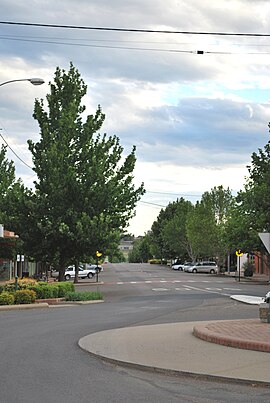Barraba
|
Barraba New South Wales |
|||||||
|---|---|---|---|---|---|---|---|

The main street of Barraba
|
|||||||
| Coordinates | 30°22′0″S 150°37′0″E / 30.36667°S 150.61667°ECoordinates: 30°22′0″S 150°37′0″E / 30.36667°S 150.61667°E | ||||||
| Population | 1,150 (2011 census) | ||||||
| Established | 1860s | ||||||
| Postcode(s) | 2347 | ||||||
| Elevation | 500 m (1,640 ft) | ||||||
| Location | |||||||
| LGA(s) | Tamworth Regional Council | ||||||
| County | Darling | ||||||
| State electorate(s) | Tamworth | ||||||
| Federal Division(s) | New England | ||||||
|
|||||||
Barraba /ˈbærəbə/ is a town in the New England region of northern New South Wales, Australia. It was formerly the centre of Barraba Shire local government area, but most of this, including Barraba, was absorbed into Tamworth Regional Council in 2004. On Census night 2011, Barraba had a population of 1,150 people. It is part of the Bundarra-Barraba Important Bird Area which is important for the conservation of the endangered regent honeyeater.
The town was the termination point for the Barraba branch railway line until it was closed.
The Kamilaroi people lived and occupied the Barraba region prior to European settlement. The first white man in area was the explorer and botanist, Allan Cunningham, in 1827. At the same time, he discovered the Manilla River, which he named Buddle's Creek. A land holding named Barraba Station was taken up around 1837 or 1838. In July 1852, the Assistant Surveyor, J. T. Gorman mapped the future townsite.
During the 1850s, gold rushes in the region helped the growth of the township. On 1 April 1856, the first Barraba Post Office opened, with a brick post office built in 1882. A school followed, opening in 1861, in rented premises. In September 1876, there was an auction of the crown lands in Barraba. In the same year, the first St Laurence's church building was built, as well as the first bank. In 1878, the Commercial Hotel was built, and three years later, the Barraba Court House was built. On 20 March 1885, Barraba was proclaimed a town. During the 1890s, many more key buildings of the township were built, including the hospital (1891) and the Weslyan Church (1898). In 1893, the population in Barraba reached 500; this increased to 1,164 in 1921.
...
Wikipedia

